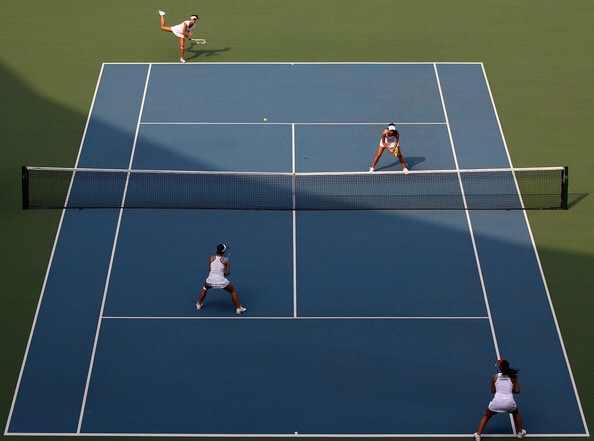There are many different formations you can use to win doubles points and good players change their formations depending on what’s happening tactically in the match and what the score is. Most club players are very familiar with the standard one up, one back formation and may occasionally use the two back on return formation, but there are a few others you should practice and become familiar with to give your opponents a different look and influence their stroke placement. Allowing your opponents to get comfortable in doubles in a death sentence. Changing their visual target and control the match.
Standard formation

In standard formation the baseline player (setter) is trying to set up the net player (spiked) who is situated in the middle of the service box and looking to play anything high down the middle of the court. Good net players in this formation give up at least half the ally to their opponents. Since down the line is generally the toughest shot and they want to stay involved in the Crosscourt play. (Notice how much of the middle of the court the net players are clogging up. Baiting the base liners to try the line).
*See how many times out of 10 you can hit the ball down the alley from a dead ball feed. The alley is tough to hit consistently!

Two back on return can be used when returners are struggling on return or are getting hammered by the net player on the 3rd ball of the point. By moving the net player back to the basline the net player is no longer vulnerable on put away volleys and can more readily play defense. This changes the serving teams attack strategy from pounding the ball through the middle or net player to using angles to win the point from net. A great formation to use when you have lost your rythm on the return or you need to make the most of aggressive groundstrokes. Lobbing the return is a great option with this formation.
Mid court and Back

This is a return formation halfway between standard and two back. It is often used against the opponents eye formation or Aussie formation. It allows the mid court player to adjust to the quality of their partners return. If the return is good and can’t be attacked the net player will quickly take forward net position. If the return is poor and is attacked the mid court player has more time to defend the next ball. This formation makes the opponents really second guess their 3rd ball targets.
Eye Formation

Eye formation is not for the faint hearted. High risk, high reward! You must be able to generate weaker replies from the serve from either power or placement to use this formation. This makes the returner think twice about the return location not knowing which way the servers net player will cover. It really takes the middle of the court out of play for the return. Using this formation you should most often target the “T” on serve to cut down the return angles and give your partner a chance to knock off the volley.
Australian Formation

Aussie formation is an effective form of the Eye set up. Both players position themselves on the same side of the Centre line. This formation really takes away the Crosscourt and middle returns. If you come across a great Crosscourt returner, use the Aussie formation to break their rhythm and force them to change direction down the line. Using this serve to the backhand or body makes it very difficult to make that down the line return. As an added bonus the server (if right handed) is running into a forehand. A great formation to really freak out your opponent on return.
*The Aussie is easier for right handers going to the Ad side and easier for left handers going to the deuce side because forehand poaches are easier than backhand poaches.
Mix up your formations in practice and you will be better able to adjust to your opponents style of play and influence their shot selection even before the serve is hit. Giving your opponent changing looks is key to successful doubles and playing at a high level.
I understand reluctance to try new formations or tactics so I would suggest incorporated some new things when the score is in your favor (40-0,40-15,5-1,5-0 ect.) By practicing some of these formations when you are up you will build some match confidence to be able to execute in later pressure situations.Work on your formations in practice and get into your opponents heads in matches.
See you on the courts!
Joel Myers
USPTA Elite Professional
Tennis Director
Manchester Grand Hyatt San Diego
Sheraton Hotel & Marina San Diego
(949)485-8679
http://www.downtowntennis-sandiego.com
http://www.coronadotennislessons.com
